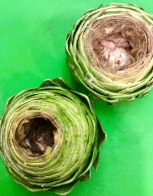Our Sunday family dinner triggered by Sarah’s barley tabbouleh turned into a festive Mediterranean-influenced evening. Carol brought an elegant tray of vegetables and a delicious spread of butternut squash and tahini. She had used a recipe from the beautiful cookbook, Jerusalem: A Cookbook by Yotam Ottolenghi and Sami Tamimi (Ten Speed Press, Berkeley, 2012).
I had thought about making pita bread, but instead I found some at the market. Home made will have to wait. The main attraction was a lamb and chick pea tagine. The purists will insist that it is not a real tagine: I browned the lamb; I used chicken stock; I used big chunks of onion so they could be picked out by the onion deniers; I braised it in the oven for hours; and I used a heavy pot instead of a classic tagine. In spite of all of that, the lamb was fork tender with Moroccan smells and tastes; served with couscous it was a big hit with everyone.
Don’t be intimidated by the long list of ingredients. Many of them are herbs and spices that you probably already have in your pantry. You can easily find the others at the grocery store. Or you can just leave out one or two. Probably nobody but one of the purists will notice.
RECIPE
Lamb and Chick Pea Tagine
Ingredients
- 1 cup dry chick peas
- 3 pounds lamb shoulder steaks, bone and heavy fat removed and cut in 1 inch cubes
- 4 tablespoons olive oil, divided
- 2 teaspoons paprika
- ¼ teaspoon ground turmeric
- ½ teaspoon ground cumin
- ¼ teaspoon cayenne pepper
- 1 teaspoon ground cinnamon
- ¼ teaspoon ground cloves
- ½ teaspoon ground cardamom
- ½ teaspoon ground ginger
- ¾ teaspoon garlic powder
- ¾ teaspoon ground coriander
- 1 teaspoon kosher salt
- 4 cups chicken broth
- 3 cloves garlic, minced
- 1 tablespoon freshly grated ginger root
- zest and juice of ½ lemon
- 1 tablespoon tomato paste
- 1 tablespoon honey
- 1 large white onion, peeled and root trimmed but intact, cut into 8 wedges
- 4 medium carrots, peeled and cut into obliques
- ½ cup dried apricots cut into 1 inch squares
- salt and pepper to taste
- 1 tablespoon corn starch stirred into 1 tablespoon water to make a slurry
Method
- In a saucepan, cover the chick peas with at least 2 inches of extra water and let stand overnight. Drain and set aside.
- In a large bowl, combine the lamb, 2 tablespoons of olive oil, paprika, turmeric, cumin, cayenne, cinnamon, cloves, cardamom, ginger, garlic powder, coriander, and salt. Mix until the lamb is completely coated. Cover tightly with plastic wrap, and refrigerate over night, stirring occasionally.
- In the morning, place the chick peas and marinated lamb in a heavy oven-proof pot. Add the chicken broth and bring to the boil over a medium-high flame. Stir in the garlic, ginger root, lemon juice and zest, tomato paste, and honey. Cover and transfer to the middle of an oven preheated to 200°F. Braise for at least 6 hours, stirring occasionally.
- About 3 hours before you plan to serve the tagine, add the onion, carrots, and dried apricots.
- When you are ready to serve, correct seasoning with salt and pepper. Transfer the meat and vegetables to a large serving platter. Place the cooking pot with the cooking liquid over a high flame and bring to a boil. Add the cornstarch slurry and stir until thickened. Serve in a gravy boat alongside the tagine.





































